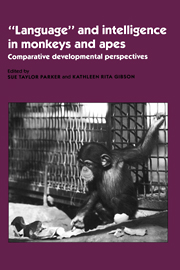Book contents
- Frontmatter
- Contents
- List of contributors
- Foreword
- Preface
- Acknowledgments
- Part I Theoretical frameworks for comparative developmental studies
- Part II Comparative developmental perspectives on cebus intelligence
- Part III Questions regarding imitation, “language,” and cultural transmission in apes and monkeys
- Part IV Developmental perspectives on social intelligence and communication in great apes
- Part V Development of numerical and classificatory abilities in chimpanzees and other vertebrates
- 16 The development of numerical skills in the chimpanzee (Pan troglodytes)
- 17 Spontaneous sorting in human and chimpanzee
- 18 Conceptual abilities of some nonprimate species, with an emphasis on an African Grey parrot
- Part VI Comparative developmental perspectives on ape “language”
- Index
18 - Conceptual abilities of some nonprimate species, with an emphasis on an African Grey parrot
Published online by Cambridge University Press: 11 May 2010
- Frontmatter
- Contents
- List of contributors
- Foreword
- Preface
- Acknowledgments
- Part I Theoretical frameworks for comparative developmental studies
- Part II Comparative developmental perspectives on cebus intelligence
- Part III Questions regarding imitation, “language,” and cultural transmission in apes and monkeys
- Part IV Developmental perspectives on social intelligence and communication in great apes
- Part V Development of numerical and classificatory abilities in chimpanzees and other vertebrates
- 16 The development of numerical skills in the chimpanzee (Pan troglodytes)
- 17 Spontaneous sorting in human and chimpanzee
- 18 Conceptual abilities of some nonprimate species, with an emphasis on an African Grey parrot
- Part VI Comparative developmental perspectives on ape “language”
- Index
Summary
Introduction
Many researchers are actively engaged in cross-species comparisons of animal intelligence. These researchers make inferences about relative intelligence by analyzing animals' overt learning behaviors in a particular experimental paradigm (e.g., numerical competence, concepts of similarity and difference, foraging and memory), as reviewed by Kamil (1988a) and Macphail (1987). Such inferences are adequate provided that the behavioral analyses are complete in terms of cause, function, evolution, and development (Burghardt, 1984; Kamil, 1984; Snowdon, 1983). Unfortunately, the study of behavior still is often partitioned between those who, as a group, study cause and development and those who study evolution and function. These two groups can be characterized, respectively, by the differing perspectives of comparative psychology and ethology (Marler & Terrace, 1984; Parker, P&G1). Comparative psychologists generally examine the cause and development of learning by comparing the mechanisms and processes in just a few animal species that are trained and tested under rigorously controlled laboratory conditions. Ethologists, in contrast, examine the function and evolution of learning by comparing natural behaviors in a variety of animals, from ants to elephants, often using closely related species to see if each species' performance depends on the particular aspects of the situation in which it is observed or tested (Kroodsma et al., 1984). Incomplete knowledge of each other's domains may cause both groups of researchers to perform experiments that are inadequate for the purpose of comparing intelligence.
- Type
- Chapter
- Information
- 'Language' and Intelligence in Monkeys and ApesComparative Developmental Perspectives, pp. 469 - 508Publisher: Cambridge University PressPrint publication year: 1990
- 40
- Cited by

